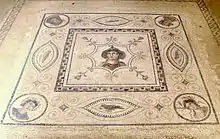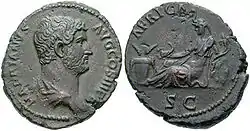Africa (goddess)
Goddess Africa, also known as Dea Africa, was the personification of Africa by the Romans in the early centuries of the common era.[1][2] She was one of the fertility and abundance deities to some. Her iconography typically included an elephant-mask head dress, curly hair, broad nose, a cornucopia, and a lion.[3][4]


She is portrayed on some coins, carved stones, and mosaics in Roman Africa. A mosaic of her is found in the El Djem museum of Tunisia.[1][5][6] A sanctuary found in Timgad (Thamugadi in Berber) features goddess Africa's iconography.[7]
Pliny the Elder, in his book Natural Story, wrote "in Africa nemo destinat aliquid nisi praefatus Africam", which scholars translate as "no one in Africa does anything without first calling on Africa".[8] This has been the literary proof of her existence and importance, in some cases interpreted as a proof for a North African goddess-centric cult. Other writers have also interpreted the female personification of Africa to be a "Dea" or goddess.[9]
Maritz, however, has questioned whether personified Africa was ever a "Dea" or goddess to Romans, or anywhere else. The iconographic images of "Dea Africa" with elephant scalp head dress was just a Roman icon for Africa, states Maritz. This is likely because neither Pliny nor any writer thereafter ever wrote "Dea" for her, nor is there an epigraphical inscription stating "Dea Africa". In contrast, other Roman goddesses carry the prefix Dea in texts and inscriptions. Romans already had their own goddesses of fertility and abundance, states Maritz, and there was no need for a competing goddess with the same deity role.[10]
Houghtalin offers a different theory, suggesting that the Roman iconography was based on the coins of King Ibaras of Numidia, a kingdom that the Roman army in Pompey defeated in 1st century BCE.[11] According to Ida Ostenberg, if Houghtalin is right, then the personification of Africa in the Roman imagination may have arrived through Pompey.[11]
References
- Gifty Ako-Adounvo (1999), Studies in the Iconography of Blacks in Roman Art, Ph.D. Thesis awarded by McMaster University, Thesis Advisor: Katherine Dunbabin, page 82
- Christine Hamdoune (2008), La dea Africa et le culte impérial, Études d'antiquités africaines, Volume 1, Numéro 1, pages 151-161
- Paul Lachlan MacKendrick (2000). The North African Stones Speak. University of North Carolina Press. p. 236. ISBN 978-0-8078-4942-2.
- Spicer, Joaneath (2016). "The Personification of Africa with an Elephant-head Crest in Cesare Ripa's Iconologia". Personification. Brill Academic. pp. 675–715. doi:10.1163/9789004310438_026. ISBN 9789004310438.
- Parrish, David (2015). "The mosaics of El Jem". Journal of Roman Archaeology. 12: 777–781. doi:10.1017/S1047759400018663. ISSN 1047-7594.
- Robert A. Wild (1981). Water in the Cultic Worship of Isis and Sarapis. Brill Archive. pp. 186–187. ISBN 90-04-06331-5.
- Aomar Akerraz; Moustapha Khanoussi; Attilio Mastino (2006). L' Africa romana: Atti del XVI convegno di studio, Rabat, 15-19 dicembre 2004. dell'Universita degli Studi di Sassari. pp. 1423, 1448. ISBN 978-88-430-3990-6.
- J. A. Maritz (2006), Dea Africa: Examining the Evidence", Scholia: Studies in Classical Antiquity, Volume 15, page 102
- Levy, Harry L. (1958). "Themes of Encomium and Invective in Claudian". Transactions and Proceedings of the American Philological Association. 89: 336–347. doi:10.2307/283685. ISSN 0065-9711.
- J. A. Maritz (2006), Dea Africa: Examining the Evidence", Scholia: Studies in Classical Antiquity, Volume 15, pages 102-121
- Ostenberg, Ida (2009). Staging the World: Spoils, Captives, and Representations in the Roman Triumphal Procession. Oxford University Press. pp. 222–223 with footnote 138. ISBN 978-0-19-921597-3.
Further reading
- Paul Corbier, Marc Griesheimer, L’Afrique romaine 146 av. J.-C.- 439 ap. J.-C. (Ellipses, Paris, 2005)